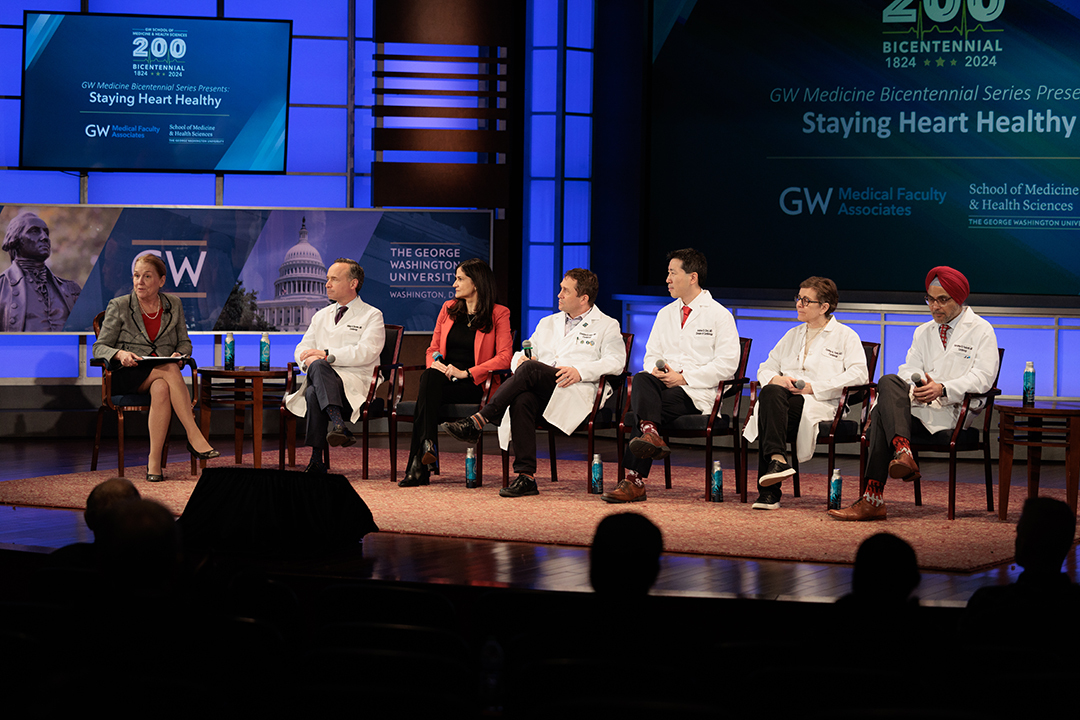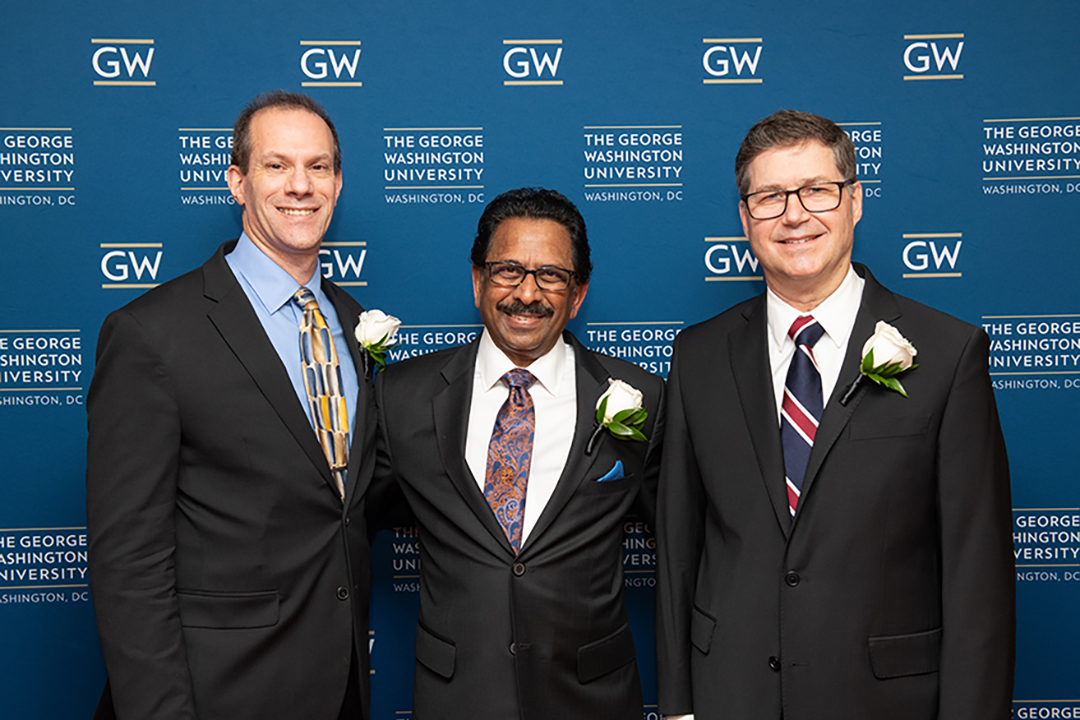Despite decades of research detailing risk factors and straightforward tactics people can use to protect themselves, heart disease remains the leading cause of death in the United States for men and women in multiple age groups and across all racial and ethnic groups.
Those statistics led the George Washington University School of Medicine and Health Sciences (SMHS) to choose Staying Heart Healthy as the inaugural topic for the school’s Bicentennial Lecture Series, highlighting the clinical programs, research initiatives and novel medical education efforts of GW’s academic medical enterprise.
Over the past 50 years, health care has witnessed considerable advances in heart health interventions and therapies, said SMHS Dean Barbara L. Bass, RESD ’86, in her introductory remarks.
“We’ve learned a lot about preventive strategies to protect people from developing heart disease in the first place, which is where we really want to be in the arc of understanding this important health condition,” said Bass, who also serves as professor of surgery, Bloedorn Professor of Administrative Medicine, vice president for health affairs and CEO of the GW Medical Faculty Associates (GW MFA).
Leading a panel of six GW cardiologists, William Borden, interim chair of the Department of Medicine, professor of medicine and of health policy at GW SMHS, and the chief quality and population health officer at the GW MFA, discussed ways the public can live heart healthy.
“We have a tremendous set of tools to work with patients, to not only treat disease when it exists, but also prevent it,” Borden told the audience of roughly 300 in person and online attendees. Patients, he said, can play an important role in that health care plan.
Broadly defined, Borden said, cardiovascular disease includes coronary artery disease, heart attacks, strokes and peripheral artery disease. “We think about them together because the risk factors that drive toward these events are the same,” he said.
'Life’s Simple Seven'
The American Heart Association developed “Life’s Simple Seven,” basic tips to reduce one’s risk for heart disease—don’t smoke, eat right, exercise, lose weight, control your blood pressure, control your cholesterol and control your blood sugar.
Know your numbers, Borden added—body mass index, blood pressure, cholesterol, blood sugar levels. “Once you have those components…you can really take steps to reduce your risk…,” he said. “You’re really covering the landscape of preventing cardiovascular disease.”
Picking up on the preventative health theme, Gurusher Panjrath, professor of medicine at SMHS, director of the Heart Failure and Mechanical Circulatory Support Program, the Infiltrative Cardiomyopathy Program, and the GW Heart and Vascular Institute, stressed attention to diet and exercise.
“Diet has had a long connection with chronic diseases,” Panjrath said. “We know that a majority of Americans know it, unfortunately, 90% of us are still lacking in the proper nutritional health.”
Dating back to 1961, the American Heart Association began focusing on the effects of diet simple food-group recommendations they hoped the public would incorporate into their daily lives.
“The key to eating is keeping it simple, going back to the basics. You don't have to go read every calorie on every component,” he said, adding, that is where patients often get bogged down in the details and fail to achieve their goals.
Women’s heart health
Ramesh Mazhari, MSHS ’14, RESD ’06, professor of medicine at SMHS, and an interventional cardiologist specializing in management of patients with coronary disease, peripheral vascular disease and valvular heart disease, turned the discussion to an often overlooked aspect of women’s health, cardiovascular health.
“Heart disease is the number one cause of mortality in women,” she said. “A third of all deaths among women are caused by cardiovascular disease.”
Equally alarming, she continued, is that the mortality from cardiovascular disease in younger women is on the rise. More women under the age of 50 are dying from cardiovascular disease, she explained, pointing to a knowledge gap among both patients and physicians as a potential cause.
“Early symptoms of heart attack in women are not easily recognized by the patients or their caregivers,” explained Mazhari. The iconic “Hollywood heart attack,” where a patient collapses with crushing chest pain is less common among women. It’s not unusual, she continued, for women having a cardiac event to experience just chest tightness, heartburn, indigestion or arm or jaw pain. “Especially in younger women, these symptoms are under-recognized.”
Recent sex-specific research studies have shown that cardiac risks for women go beyond the traditional high blood pressure, diabetes, hypertension, smoking risk factors. “What happens during pregnancy sometimes determines the risk of the woman for cardiovascular disease for decades to come,” she said.
Other factors, such as early menopause or polycystic ovary syndrome, can increase risk as well. “What we’re doing now is taking a broader look at risk assessment when it comes to women,” said Mazhari. “We call these ‘risk enhancers.’”
Technology and heart health
Turing to technologically driven advances, Christian Nagy, associate professor of medicine at SMHS, addressed cardiac interventions when lifestyle and medication are no longer enough to maintain heart health. Like parts in your car, he explained, sometimes the heart experiences mechanical failures.
“One of the most important valves sits between the heart and the body, and that is called the aortal valve,” Nagy told the audience. “With time and wear and tear, that aortic valve can break down. Unfortunately, it's a mechanical problem, and there's no medication that can reverse that, so we have to replace the valve.”
Traditionally, patients undergo open heart surgery to replace valves. While that is still a good option for many patients, over the past decade an alternative therapy—Transcatheter Aortic Valve Replacement or TAVR—has emerged that makes heart valve replacement safer, less painful and dramatically reduces recover time.
TAVR, explained Nagy, who also serves as the director of structural health disease at GW MFA and director of the Cardiac Catheterization Laboratory at the Washington, D.C., Veterans Affairs Medical Center, lasts about an hour, during which a replacement valve is delivered to the heart using a catheter through the femoral artery. Once there, surgeons stitch it in place inside the existing valve. “Most patients go home the next day…a major shift” in comparison to a conventional valve replacement, requiring as much as a week in the hospital and several more at home in recovery.
Turning to GW’s resident expert in heart arrhythmias, Cynthia Tracy, professor of medicine at SMHS and associate director of the Division of Cardiology and director of electrophysiology at the GW MFA, discussed the role computer technology is having on cardiac care.
An arrhythmia, she explained, means that your heart is not beating the way it was intended. Some of these arrhythmias are benign. “Part of my job is distinguishing who has a heart rhythm problem that is benign versus somebody who has a heart rhythm problem that really needs to be treated,” she said.
For those suffering from serious heart rhythm disturbances, Tracy said, cardiologists have a variety of procedures to help get those abnormal rhythms under control, and new technology has made that process more precise.
“We have the ability to map the electrical activation in the heart to exactly see how the electricity is traveling from one position to another,” Tracy said.
Over the years, she explained, clinical researchers have developed practical mapping tools for the heart that guide them during cardiac ablation—using heat or cold energy to create tiny scars in the heart that block faulty heart signals and restore a typical heartbeat.
Rounding out the panel of experts was Andrew Choi, M.D. ’07, B.A. ’03, associate professor of medicine and of radiology at SMHS, the co-director of multimodality cardiac imaging at the GW MFA.
Choi discussed the rapid rise of artificial intelligence in cardiology and health care in general. AI technology is pervasive across society, he said, “incorporating every part of our everyday life,” from shopping algorithms to cell phone facial recognition and even self-driving cars. When it comes to medicine, the uptake has been more measured.
Some AI based technologies, Choi said, “use big data, electronic medical records, and leverage the knowledge accrued over millions or tens of millions of patients, to predict a patient’s likelihood of developing heart disease or experiencing a heart attack.”
There are, cautioned Choi, caveats to consider when turning to artificial intelligence in health care, including privacy issues and safety. Currently, the FDA deems AI tools as “clinical decision support,” leaving the final responsibility in the hands of doctors and their patients. Ultimately, however, it will be one of those advances that changes our understanding of disease and expand our opportunities to intervene.
For more information about heart health or to schedule an appointment with a GW cardiologist, call (202) 741-2323 or visit the website at GWdocs.com/cardiology.





